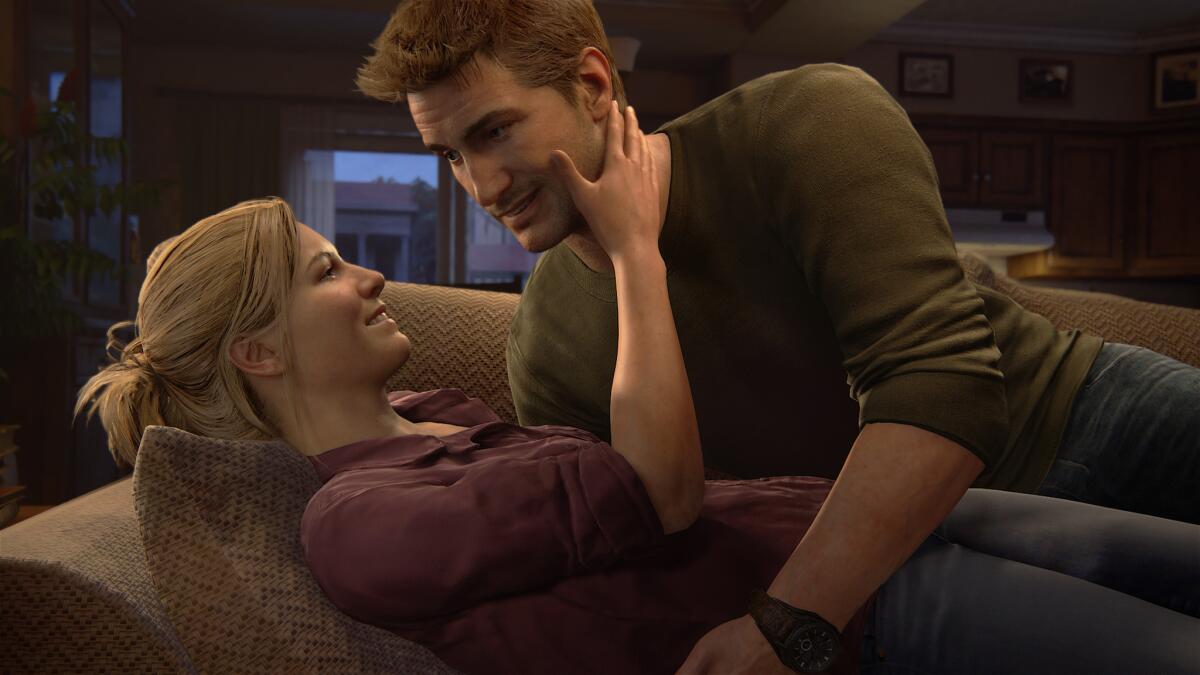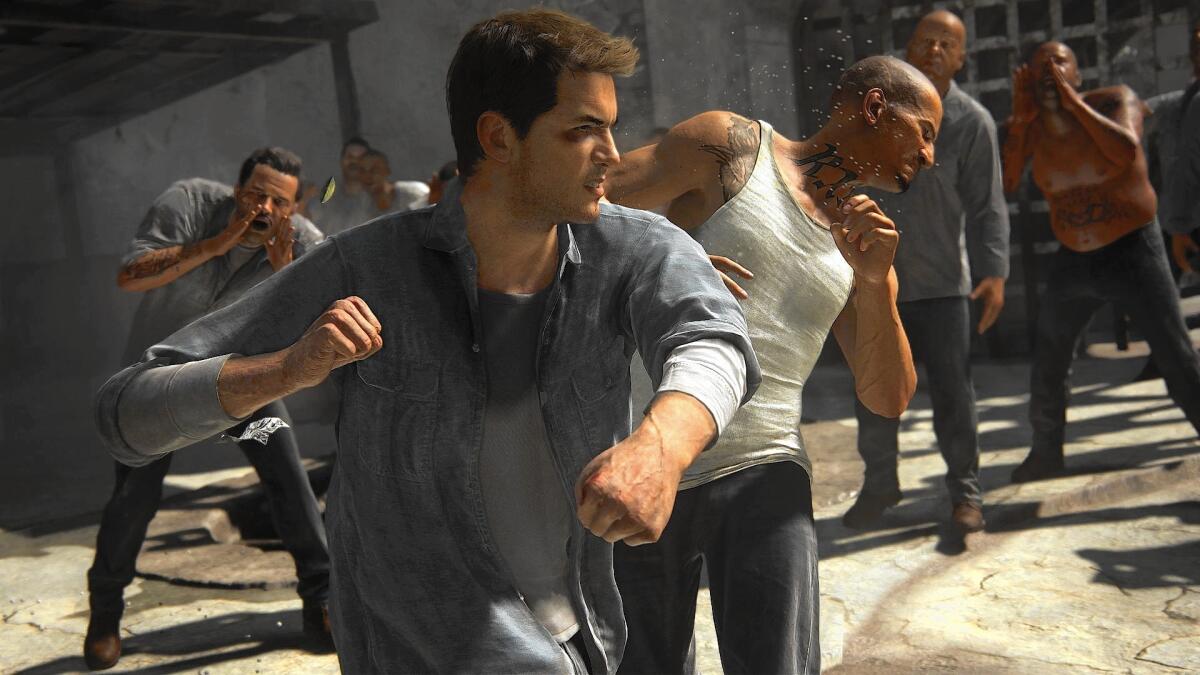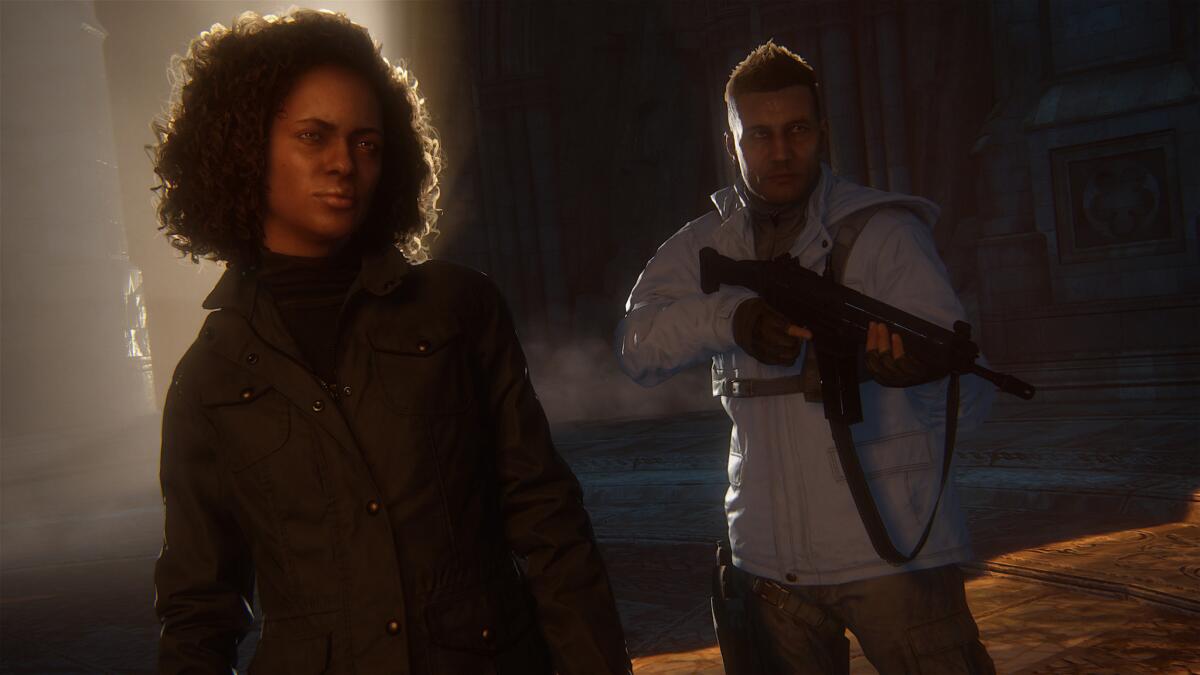The Player: ‘Uncharted 4: A Thief’s End’ serves up action ... and personal issues

The “Uncharted” franchise has been defined by remarkable action sequences — a full-on shootout on a moving train, a somersaulting Jeep, an extended battle of man versus helicopter.
“Uncharted 4: A Thief’s End” has blockbuster-to-be sequences of its own, including chaotic chases at sea and high-flying stunts. It just may be the best action movie you will play this summer. But now there’s something of a pall presiding over the whole hunt-for-relics action. It comes down to three words spoken early in the game — a simple question with a complicated answer from a wife to a husband: “Are you happy?”
And thus the game becomes something much deeper. Lurking beneath the surface of “A Thief’s End’s” action — the quest for one last fortune of nearly unexplainable wealth — and behind the smirks and one-liners of Nathan Drake, the game’s leading man, is a character drama. Consider it a video game shooter that doesn’t feel like a video game shooter, where a player’s reflexes are put through as much of a test as a couple’s marriage.
“It’s a little uncomfortable at times when you’re playing the game,” says Bruce Straley, the game’s co-director. “That’s what I like. It’s not all action. It’s not all burning buildings. There are quiet moments.”
And there are bigger questions than whether Drake will uncover ancient ruins and erase his brother’s debts, a journey he undertakes by lying to his wife. Says Neil Druckmann, a co-director and writer on the project, “How do we make a relationship in jeopardy feel interactive?”

“Uncharted 4: A Thief’s End” has chaotic chases at sea and high-flying stunts. But the adventures are only part of the game.
“Uncharted 4,” being released Tuesday for the PlayStation 4, brings the franchise to an end — Druckmann and Straley swear there will be no further adventures of Drake — and into new territory. At times, the pulpy action series gets reflective with ruminations about the comfort of family versus the power of independence, and tackles themes of addiction along the way.
Getting here wasn’t easy.
“Uncharted 4’s” production was marked by personnel shifts and controversial last-minute decisions, such as having a white actress voice one star of the game, a black character. Months of work were discarded when Straley and Druckmann joined the project, as the direction was shifted and the decision was made that this would be the final “Uncharted” game, bringing to an end one of the most successful franchises of Sony-owned Santa Monica studio Naughty Dog.
Druckmann and Straley, coming off of the hit game “The Last of Us,” a thriller that’s as much about a would-be father-daughter-like relationship as it is about putting bullets in the heads of zombies, speak of “Uncharted 4” as if it’s an experiment. Can they, in a mainstream blockbuster video franchise, one that has sold more than 21 million copies worldwide, essentially create a character study?
Forget the thrill of adventure, “Uncharted 4” wants to know why someone wants to adventure at all, especially when it puts his own life and the lives of his loved ones at risk.
Talk to Druckmann about the project and he’ll reference “Breaking Bad” and “Six Feet Under” as often as “Star Wars: The Force Awakens,” for this is a game where a couple playing video games on a couch becomes as grand a set piece as a man scaling buildings and jumping from rooftop to rooftop. It is, unmistakably, the work of Druckmann and Straley, a video game design team who believe the interactive experience should feel as directed as the cinematic one.
But in this relatively new medium, one defined by giving the players the illusion of going anywhere and doing anything, will fans buy into the pair’s vision of a more serious, more personal video game?
Some people want wall-to-wall action. Maybe this is selfish, but I don’t make games for them.
— Neil Druckmann
“I’m not nervous about it,” says the 37-year-old Druckmann. “I’ve accepted that some people are not going to like it. Some people want wall-to-wall action. Maybe this is selfish, but I don’t make games for them. I make the kind of games I want to play, and I want that balance. I want things to slow down so that the action sequences have more meaning. It’s as simple as that.”
Little is publicly known about the direction “Uncharted 4” would have taken before Druckmann and Straley joining the title. “It’s a delicate thing to talk about,” says Druckmann, who joined Naughty Dog as an intern in 2004.
Veteran game developer Amy Hennig, who had long been associated with the “Uncharted” franchise, was previously spearheading the game. But Hennig and Naughty Dog parted ways, and it was unveiled in 2014 that she would be joining Electronic Arts studio Visceral Games to work on a “Star Wars” project. “Uncharted” scripts were jettisoned, voice work was discarded and a new direction was plotted.
“They just weren’t our ideas,” says Druckmann.
“If we were trying to finish it, we’d be constantly asking, ‘What was this other person trying to do here?’ We would intellectualize everything and have no instinct,” he adds. “That’s a road to failure.”
To get energized about the game, the pair made one key decision early on: This would be the last “Uncharted” title. Today, Straley jokes that only if Naughty Dog falls into financial ruin will there be another “Uncharted” game. Both say the formula, one of Nathan Drake going off on adventures and then living happily ever after with the character of Elena, was not sustainable.
“It felt like there wasn’t much more to do with this character unless we were to wrap it up, unless we were to see a final change or a final event that would culminate all these experiences into a final choice — a revelation — as to how this person really is,” says Druckmann. “That’s something exciting. That’s something we could get behind. Otherwise, we’d just be telling the same story. That seemed less interesting. That felt like padding, just stretching out.”
Adds Straley, a 16-year veteran of Naughty Dog, “He’s not James Bond. It’s not that world. We explored the limits.”
“Uncharted 4,” right from the beginning, shows a more vulnerable Drake. He’s working as a longshoreman, trying to settle into life with a 9-to-5 and a suburban house.
His treasures, many of which should belong in a museum, are cluttered around his attic office. He’s become a hoarder, and he gets his kicks by running around his man cave with a toy gun. Rather than galavant around the globe, Elena is writing travel stories, and after a couple of opening action sequences, the game slows down to show the challenges of domesticated life.
“He has a crazy obsession, arguably an addiction,” Straley says of Drake’s desire to seek lost treasures.”Then we started talking about metaphors with drug addiction. Why does he have that? What has been missing in his life that he relies on adventures and he has to be on the brink of death to feel alive?
“Vices,” he says. “Like an addict. It tastes really great eating that bag of Doritos, but when you’re done, you got some consequences. Those are the things that we saw that we could play in ‘Uncharted 4.’”
The evolution of Drake also reflects a gradual change in thinking about game design. When “Uncharted” debuted about 10 years ago, stories in top-flight games weren’t always placed at a premium. Reflecting on the first game, 2007’s “Drake’s Fortune,” Druckmann says Naughty Dog focused too heavily on blockbuster moments.
“We weren’t confident how much combat there should be,” he says. “You can argue that ‘Uncharted 1’ has too much combat. A lot of it was retrofitted after the fact, when we realized the game wasn’t as long as we wanted it to be, so we were padding it with more action.”
The game didn’t flow. Loud moments immediately butted against softer ones, and storytelling was often relegated to in-game cinematic sequences, moments in which control was taken from the player. Though “Uncharted 4” has plenty of scripted scenes, Druckmann and Straley are also giving the player greater management over Drake’s dialogue, and Drake today may fetch dinner in addition to lost maps.
“When it’s balls-to-walls action, and your life is at stake, you don’t get to see relationships because it’s all about survival,” says Druckmann. “It’s all about, ‘Oh, my God! We’ve got to get over there! Run!’ There’s no nuance. The characters are just screaming. So to see another dimension of the characters, you have to slow things down. You have to have low-stakes scenarios.”
There were other challenges with joining a project well underway, such as a lack of pre-production time. New roles were added, and because of the rushed nature of the game were sometimes cast before they were designed. One such character, South African antagonist Nadine, went to actress Laura Bailey. Then things, admittedly, “get complicated,” says Druckmann, as Nadine is black, and Bailey is not.
Druckmann is careful and patient when discussing the incident, noting that Bailey was cast for her ability to play off other cast members, and character designs were far from finished. Once the concept art came in, Druckmann says the studio faced a dilemma.
“What are our options? We cannot go with this concept. We can make her white. No one would think anything of it. What are our priorities? If our priority is to just have a strong female character and avoid controversy ... then you make her white. If our goal is being progressive and that’s the most important thing, then you recast Laura. You should cast a black actor for this part. But it’s not so simple. This project had no time to recast. And Laura, to me, was the character. I couldn’t imagine another person playing this character.
“So,” he says, “I punted.”

A screenshot from Naughty Dog’s “Uncharted 4: A Thief’s End.”
Druckmann adds he never told Bailey the character’s skin color and says that once it was in the game, he no longer saw Bailey.
“I see Nadine Ross,” he says. “I see this really intriguing character I’ve never seen in a video game before. I know there’s going to be controversy when this thing comes out, but this is where we’ve ended up. For the time we had to make the game, this was the best choice. That’s what I’m going to go with it. I wouldn’t change it.”
A risk, but one of many taken by “Uncharted 4.”
“It’s going to cause a lot of friction,” says Straley. “I know it. It’s going to cause some controversy. Everybody wants the shooting and the action and the over-the-top and the collapsing buildings and the helicopters exploding and the awesome, but to have conflict in your heart, and to maybe agree or disagree with Nathan, is what we want to get to.”
More to Read
The biggest entertainment stories
Get our big stories about Hollywood, film, television, music, arts, culture and more right in your inbox as soon as they publish.
You may occasionally receive promotional content from the Los Angeles Times.







